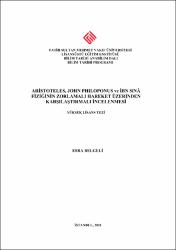| dc.contributor.advisor | Kaçar, Mustafa | |
| dc.contributor.author | Belgeli, Esra | |
| dc.date.accessioned | 2021-04-19T12:10:54Z | |
| dc.date.available | 2021-04-19T12:10:54Z | |
| dc.date.issued | 2021 | en_US |
| dc.identifier.citation | BELGELİ, Esra, Aristoteles, John Philoponus ve İbn Sînâ Fiziğinin Zorlamalı Hareket Üzerinden Karşılaştırmalı İncelenmesi, Fatih Sultan Mehmet Vakıf Üniversitesi Lisansüstü Eğitim Enstitüsü Bilim Tarihi Anabilim Dalı, Yayımlanmamış Yüksek Lisans Tezi, İstanbul 2021. | en_US |
| dc.identifier.uri | https://hdl.handle.net/11352/3296 | |
| dc.description.abstract | 17. yüzyılda Isaac Newton’un Principia’sında Hareket ve Yerçekimi
Yasaları’yla son halini verdiği hareket kavramı Antik Yunan’da Aristoteles ve İslam
Dünyası’nda İbn Sînâ gibi filozofların üzerinde çalıştığı en önemli konulardan biri
olmuştur. İbn Sînâ Kitâbu'ş-Şifa külliyatının Fizik kitabında, Aristotelesçi geleneği
takip ederek doğa felsefesi kapsamında hareket konusunda çalışmalarını sürdürmüş ve
kasri meyil teorisini ortaya atmıştır. Bu çalışmada İbn Sînâ’nın Aristoteles’ten
devraldığı bilim mirasının hareket konusundaki gelişmeleri ve onun sonraki çağlara
etkisi incelenmiştir. Bunu yaparken öncelikle Aristoteles’in genel doğa felsefesi,
hareket ilkeleri ve zorlamalı hareket hakkındaki görüşleriyle başlayıp, onun fikirlerine
yorumlar, şerhler ve reddiyeler yazan John Philoponus’un impetus teorisine değinerek
ardından İbn Sînâ’nın hareket ilkeleri ve kasri meyil teorisi incelenmiştir. İbn Sina’nın
Aristoteles ve Philoponus’un dinamik konusunda görüşlerine katıldığı ve onlardan
ayrıldığı noktalar tespit edilip İbn Sina’nın dinamik teorisinin özgün yönleri
belirginleştirilmiştir. İbn Sina’nın dinamiğinin modern fiziğe katkısı ve etkisi
değerlendirilip çalışma sonuçlandırılmıştır. | en_US |
| dc.description.abstract | The concept of motion which Isaac Newton put the final form of it in his
Principia with the Laws of Motion and Gravity in the 17th century, was one of the
most important issues that philosophers like Aristotle in Ancient Greece and Ibn Sînâ
in the Islamic World worked on. Avicenna in the Physics book of the Healing,
continued his studies on motion within the scope of natural philosophy by following
the Aristotelian tradition and put forward the theory of forced inclination. In this study,
the developments of the scientific heritage that Avicenna inherited from Aristotle and
its effects on the next ages are examined. In doing so first of all, starting with
Aristotle’s general philosophy of nature, principles of motion and forced motion, then
refering to the impetus theory of John Philoponus who wrote comments, explanations
and rejections to Aristotle’s ideas, finally Avicenna’s principles of motion and his
forced inclination (mayl) theory were examined. The points where Avicenna agreed
with Aristotle and Philoponus’ views on dynamics and where he differed from them
were determined and the original aspects of Avicenna’s dynamic theory were clarified.
The contribution and impact of Avicenna’s dynamics on modern physics was
evaluated and the study was concluded. | en_US |
| dc.language.iso | tur | en_US |
| dc.publisher | Fatih Sultan Mehmet Vakıf Üniversitesi, Lisansüstü Eğitim Enstitüsü | en_US |
| dc.rights | info:eu-repo/semantics/openAccess | en_US |
| dc.subject | İbn Sînâ | en_US |
| dc.subject | Fizik | en_US |
| dc.subject | Doğa Felsefesi | en_US |
| dc.subject | Hareket | en_US |
| dc.subject | Kasri Meyil Teorisi | en_US |
| dc.subject | İmpetus Teorisi | en_US |
| dc.subject | Avicenna | en_US |
| dc.subject | Physics | en_US |
| dc.subject | Natural Philosophy | en_US |
| dc.subject | Motion | en_US |
| dc.subject | Impetus Theory | en_US |
| dc.subject | Forced Inclination (Mayl) Theory | en_US |
| dc.title | Aristoteles, John Philoponus ve İbn Sînâ Fiziğinin Zorlamalı Hareket Üzerinden Karşılaştırmalı İncelenmesi | en_US |
| dc.title.alternative | A Comparative Study of Aristotle, John Philoponus and Ibn Sina’s Physics on Forced Motion | en_US |
| dc.type | masterThesis | en_US |
| dc.contributor.department | FSM Vakıf Üniversitesi, Lisansüstü Eğitim Enstitüsü, Bilim Tarihi Ana Bilim Dalı | en_US |
| dc.relation.publicationcategory | Tez | en_US |
| dc.contributor.institutionauthor | Belgeli, Esra | |



















